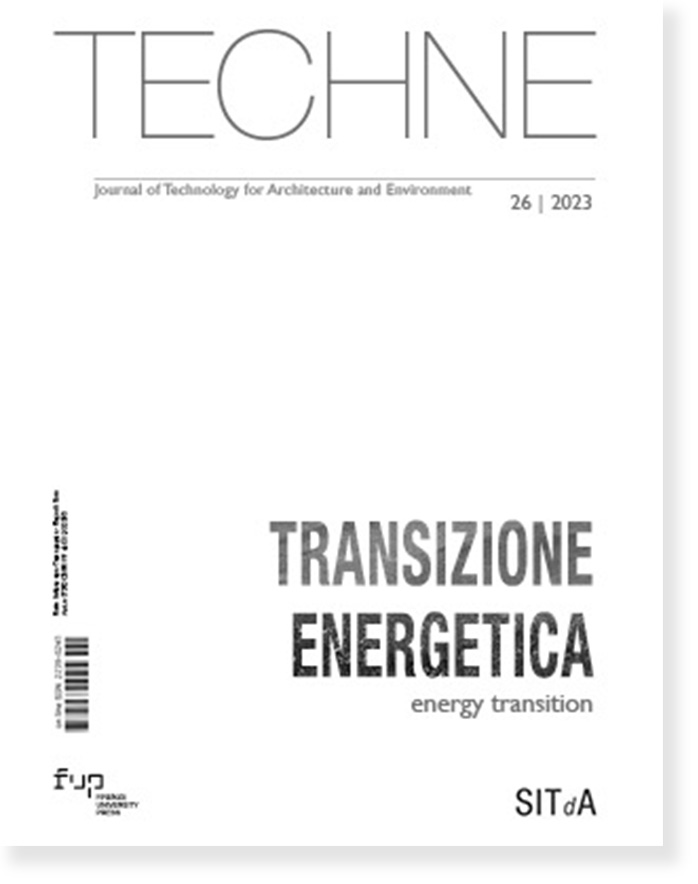Published 2023-10-31
Keywords
- Building Life Cycle,
- Embodied & Operational Carbon,
- Decarbonization,
- Whole Life Carbon
How to Cite
Copyright (c) 2023 Jacopo Andreotti, Roberto Giordano

This work is licensed under a Creative Commons Attribution 4.0 International License.
Abstract
The initiatives launched downstream of the Paris Climate Agreement, as well as the work on the revision of the EPBD Directive, have as their primary objective the development of a roadmap for the energy transition and decarbonisation of the construction sector by 2050. The research “Tools for Decarbonization” was developed in this context. Green Building Council Italia has funded it and is part of the European project #BuildingLife. The study plans to define a set of indicators to account for CO2 emissions in different stages of the building’s lifecycle, and to assess the Whole Life Carbon of the building itself, i.e., its overall carbon footprint.
Downloads
References
British Standards Institution (2016), Carbon Management in Infrastructure. Available at: https://knowledge.bsigroup.com/products/carbon-management-in-infrastructure/standard (Accessed on 22/02/2023).
Commissione Europea (2020), COM(2020) 98 final: Un nuovo piano d’azione per l’economia circolare Per un’Europa più pulita e più competitiva. Available at: https://eur-lex.europa.eu (Accessed on 24.02.2023).
Commissione Europea (COM) (2021), COM(2021) 802 final: Proposal for a Directive of the European Parliament and of the Council on the Energy Performance of Buildings (recast) – EPBD. Available at: https://eur-lex.europa.eu (Accessed on 23/02/2023).
Department for Business, Energy & Industrial Strategy (BEIS) (2022), Greenhouse gas reporting: conversion factors 2022. Available at: https://www.gov.uk/government/publications/greenhouse-gas-reporting-conversion-factors-2022 (Accessed on 25/02/2023).
Dodd, N., Cordella, M., Traverso, M., Donatello, S. (2017), Level(s) – A common EU framework of core sustainability indicators for office and residential buildings, Publications Office of the European Union, Luxembourg.
Global Alliance for Buildings and Construction (GlobalABC) (2020), GlobalABC Roadmap for Buildings and Construction: Towards a zero-emission, efficient and resilient buildings, and construction sector. Available at: https://globalabc.org/roadmaps-buildings-and-construction (Accessed on 22/02/2023).
Green Building Council Italia (GBC Italia) (2022), Decarbonizzare il ciclo di vita dell’ambiente costruito. Roadmap italiana per raggiungere gli obiettivi climatici al 2050. Available at: https://gbcitalia.org/wp-content/uploads/2022/12/gbcitalia_roadmap_2050.pdf (Accessed on 22/02/2023).
Intergovernmental Panel on Climate Change (IPCC) (2021), Climate Change 2021: The Physical Science Basis. Contribution of Working Group I, Cambridge University Press.
Istituto Superiore per la Protezione e la Ricerca Ambientale (2021), Rapporto 363/2022: Indicatori di efficienza e decarbonizzazione del sistema energetico nazionale e del settore elettrico. Available at: https://www.isprambiente.gov.it/files2022/pubblicazioni/rapporti/r363-2022.pdf (Accessed on 23/02/2023).
Pomponi, F., Moncaster, A. (2019), “Scrutinising embodied carbon in buildings: The next performance gap made manifest”, Renewable and Sustainable Energy Reviews, Vol. 81, n. 2, pp. 2431-2442. Available at: (Accessed on 22/02/2023).
South Coast Air Quality Management District (South Coast AQMD) (2023), Off-road Mobile Source Emission Factor (Scenario Years 2007 – 2025). Available at: http://www.aqmd.gov/home/rules-compliance/ceqa/air-quality-analysis-handbook/off-road-mobile-source-emission-factors (Accessed on 23/02/2023).
Unione Europea (2021), Regolamento (UE) 2021/1119: Normativa europea sul clima. Available at: https://eur-lex.europa.eu (Accessed on 22/02/2023).
World Green Building Council (WBGC) (2022), Advancing Net Zero Status Report. Available at: https://worldgbc.org/advancing-net-zero/ (Accessed on 28/02/2023).






